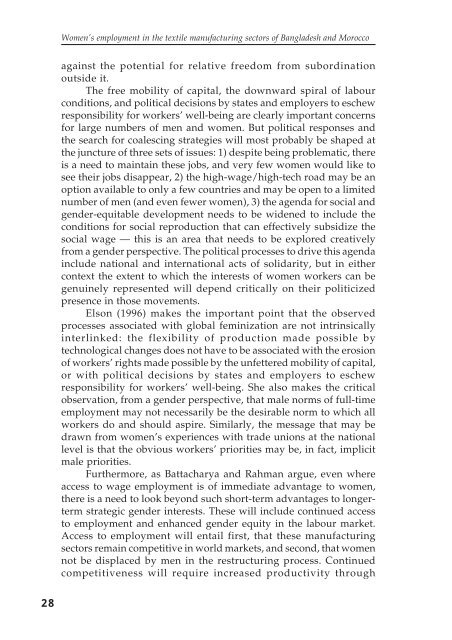Women's Employment - United Nations Research Institute for Social ...
Women's Employment - United Nations Research Institute for Social ...
Women's Employment - United Nations Research Institute for Social ...
You also want an ePaper? Increase the reach of your titles
YUMPU automatically turns print PDFs into web optimized ePapers that Google loves.
Women’s employment in the textile manufacturing sectors of Bangladesh and Morocco<br />
against the potential <strong>for</strong> relative freedom from subordination<br />
outside it.<br />
The free mobility of capital, the downward spiral of labour<br />
conditions, and political decisions by states and employers to eschew<br />
responsibility <strong>for</strong> workers’ well-being are clearly important concerns<br />
<strong>for</strong> large numbers of men and women. But political responses and<br />
the search <strong>for</strong> coalescing strategies will most probably be shaped at<br />
the juncture of three sets of issues: 1) despite being problematic, there<br />
is a need to maintain these jobs, and very few women would like to<br />
see their jobs disappear, 2) the high-wage/high-tech road may be an<br />
option available to only a few countries and may be open to a limited<br />
number of men (and even fewer women), 3) the agenda <strong>for</strong> social and<br />
gender-equitable development needs to be widened to include the<br />
conditions <strong>for</strong> social reproduction that can effectively subsidize the<br />
social wage — this is an area that needs to be explored creatively<br />
from a gender perspective. The political processes to drive this agenda<br />
include national and international acts of solidarity, but in either<br />
context the extent to which the interests of women workers can be<br />
genuinely represented will depend critically on their politicized<br />
presence in those movements.<br />
Elson (1996) makes the important point that the observed<br />
processes associated with global feminization are not intrinsically<br />
interlinked: the flexibility of production made possible by<br />
technological changes does not have to be associated with the erosion<br />
of workers’ rights made possible by the unfettered mobility of capital,<br />
or with political decisions by states and employers to eschew<br />
responsibility <strong>for</strong> workers’ well-being. She also makes the critical<br />
observation, from a gender perspective, that male norms of full-time<br />
employment may not necessarily be the desirable norm to which all<br />
workers do and should aspire. Similarly, the message that may be<br />
drawn from women’s experiences with trade unions at the national<br />
level is that the obvious workers’ priorities may be, in fact, implicit<br />
male priorities.<br />
Furthermore, as Battacharya and Rahman argue, even where<br />
access to wage employment is of immediate advantage to women,<br />
there is a need to look beyond such short-term advantages to longerterm<br />
strategic gender interests. These will include continued access<br />
to employment and enhanced gender equity in the labour market.<br />
Access to employment will entail first, that these manufacturing<br />
sectors remain competitive in world markets, and second, that women<br />
not be displaced by men in the restructuring process. Continued<br />
competitiveness will require increased productivity through<br />
28
















